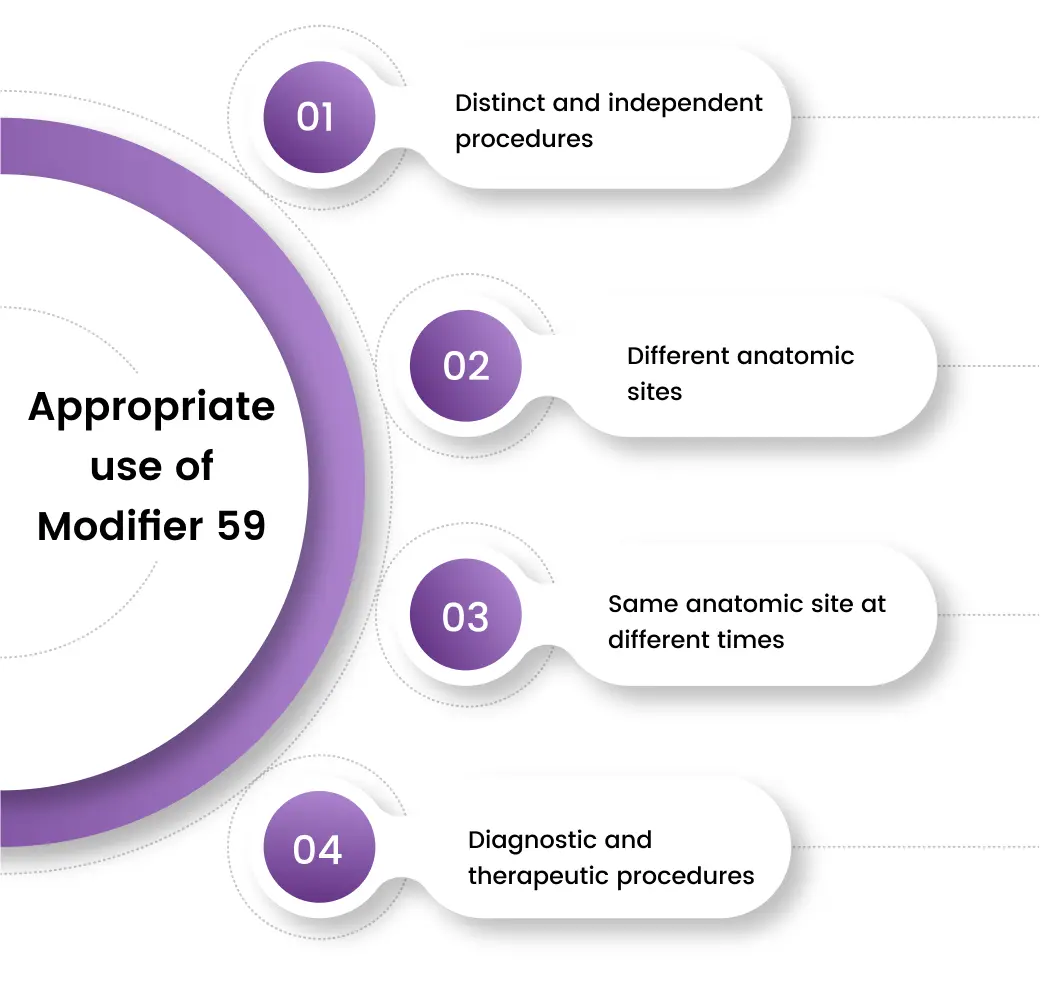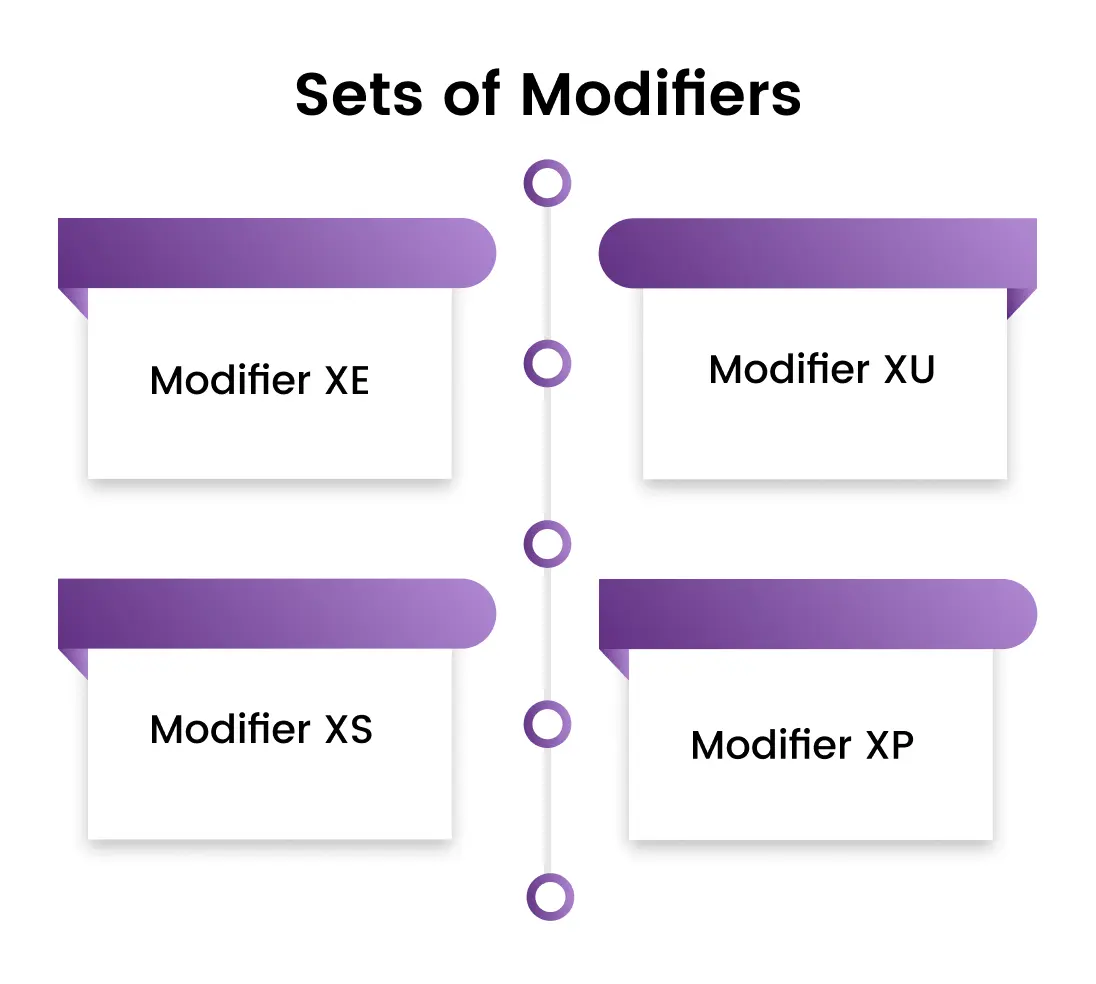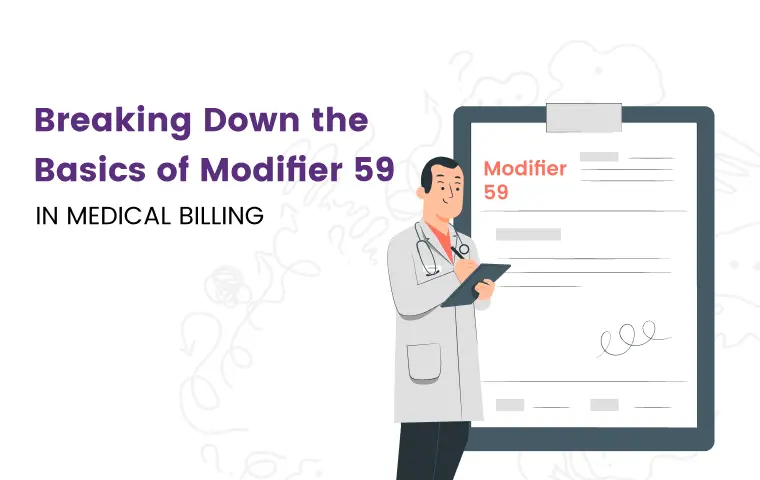If you've ever dealt with medical billing, chances are you've come across the term "modifier 59" at some point. You might have found yourself scratching your head and wondering what on earth it means.
Well, fear not! In this blog, we'll be delving into the world of medical billing and exploring the ins and outs of modifier 59. But don't worry, we won't be getting stucked in jargon and technicalities - we'll be keeping things light. So buckle up and get ready to learn something new!
Table of Contents
What is a 59 modifier?
59 Modifier AKA Distinct Procedural Service indicates that procedure or service performed was distinct or independent from other services or procedures performed on the same day. In other words, it is used to distinguish a service that is not normally reported together with another service provided during the same encounter.
Modifier 59 is frequently applied to a Current Procedural Terminology (CPT) code that is typically not eligible for separate payment when performed in conjunction with another procedure, but should be reimbursed under certain circumstances.
Appropriate use of Modifier
So at this time you may have got an idea about what is a 59 modifier but the story doesn’t ends here you may think of when to use 59 modifier and what should be an appropriate use of this 59 modifier.
The appropriate use of modifier 59 in medical billing includes situations where:

- Two or more CPT codes describe procedures or services that are distinct and independent from each other and are performed during the same encounter.
- Two or more CPT codes are performed at different anatomic sites or body regions during the same encounter, and the codes would not usually be reported together.
- Two or more CPT codes describe procedures or services that are performed on the same anatomic site or body region but at different times or during different sessions.
- A CPT code that describes a diagnostic procedure is performed during the same encounter as a therapeutic procedure, and the diagnostic procedure is not an integral component of the therapeutic procedure.
Here are examples for each of the four situations where the use of modifier 59 is appropriate:
Distinct and independent procedures: A patient presents to the emergency room with a broken arm and a laceration on their leg. The physician performs a reduction of the broken arm (CPT code 24500) and sutures the laceration on the leg (CPT code 12031). In this case, modifier 59 would be appended to CPT code 12031 to indicate that it was a distinct and independent procedure from the reduction of the broken arm.
Different anatomic sites: A patient presents with a sore throat and a rash on their leg. The physician performs a strep test (CPT code 87880) and a biopsy of the rash (CPT code 11102). In this case, modifier 59 would be appended to CPT code 11100 to indicate that the biopsy of the rash was performed on a different anatomic site than the strep test.
Same anatomic site at different times: A patient undergoes a colonoscopy (CPT code 45378) and a biopsy of a polyp (CPT code 45380) during the same encounter. The biopsy of the polyp was performed on a different day from the colonoscopy. In this case, modifier 59 would be appended to CPT code 45380 to indicate that it was performed on a different day from the colonoscopy.
Diagnostic and therapeutic procedures: A patient undergoes a diagnostic bronchoscopy (CPT code 31622) and a bronchial lavage (CPT code 31623) during the same encounter. The bronchoscopy was performed to diagnose a lung condition, while the bronchial lavage was performed to treat the same condition. In this case, modifier 59 would be appended to CPT code 31622 to indicate that it was a separate and distinct diagnostic procedure from the therapeutic bronchial lavage.
Modifier 59 and NCCI Edits
Modifier 59 has the ability to override National Correct Coding Initiative (NCCI) edits when used appropriately. NCCI is a program developed by the Centers for Medicare & Medicaid Services (CMS) to promote correct coding practices and prevent improper payments in the Medicare program.
NCCI edits are a set of pre-established code pairings that identify procedures that are considered to be mutually exclusive, meaning that they should not be reported together under most circumstances.
In some cases, however, it may be necessary to report both procedures separately, which is where modifier 59 comes in. When modifier 59 is applied correctly to the second procedure, it indicates that it is a distinct and independent service from the first procedure and should be reimbursed separately.
For example, if a provider performs a surgical procedure that includes the removal of a lesion and the repair of a wound on the same site, NCCI edits would typically bundle these codes together and only reimburse for one of the procedures.
However, if the provider can demonstrate that the removal of the lesion was a separate and distinct procedure from the repair of the wound, they may append modifier 59 to the code for the wound repair to override the NCCI edit and receive separate reimbursement for both procedures.
Other Sets of Modifiers
The other modifiers are used instead of modifier 59 in certain situations to provide more specific information about the services provided. Using the appropriate modifier in each situation helps to ensure accurate reimbursement and prevent potential denials or audit scrutiny. It also helps to provide a more complete and accurate picture of the services provided and their relationship to each other.

- Modifier XE
- Modifier XS
- Modifier XP
- Modifier XU
Modifier XE
This modifier is used to indicate that two services were performed on separate encounters or different dates of service. For example, if a patient receives a service on one day and returns for a similar service on another day, the provider may use modifier XE to indicate that the services were performed on separate dates.
Modifier XS
This modifier is used to indicate that two services were performed on separate structures or organs that are not anatomically related. For example, if a provider performs a biopsy on the skin and a biopsy on the liver during the same encounter, they may use modifier XS instead of modifier 59 to indicate that the procedures were performed on separate structures.
Modifier XP
This modifier is used to indicate that two services were performed by different providers in different locations. For example, if a patient receives a service from one provider in a hospital and then receives a service from another provider in an outpatient clinic, the providers may use modifier XP to indicate that the services were performed in separate locations.
Modifier XU
It is used to identify procedures or services that are nevertheless distinct and separate from other services performed on the same day. It's worth noting that the use of modifier XU should be limited to situations where no other modifier accurately describes the relationship between the services provided.
Final Words
And that is everything you need to know about modifier 59 in medical billing! We hope that we've been able to shed some light on this somewhat confusing topic and that you now feel more informed about how to use this modifier appropriately.
Remember, the key to using modifier 59 (and all other modifiers) correctly is to ensure that you are providing accurate and specific information about the services provided, and that you are following CMS guidelines and best practices.
ABOUT AUTHOR

Sam Curran
As a blog writer with years of experience in the healthcare industry, I have got what it takes to write well researched content that adds value for the audience. I am a curious individual by nature, driven by passion and I translate that into my writings. I aspire to be among the leading content writers in the world.
